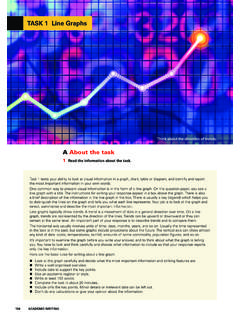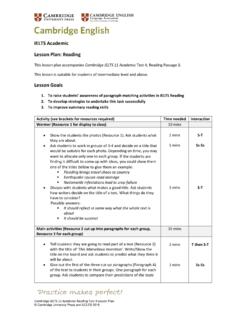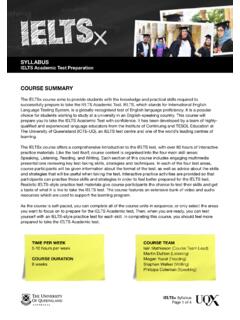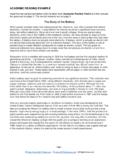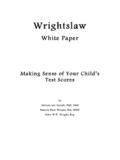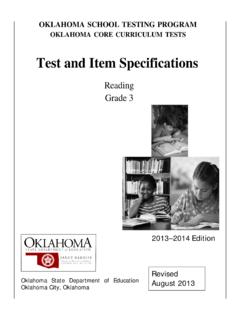Transcription of TASK T YPE 2 Identifying information: True/False/Not Given ...
1 Task type 2 Identifying information : True/False/Not Given TASK TYPE 1 Identifying information ( True/False/Not Given ). If there's not enough information , write NOT Given . Dunes of the Sahara Desert, Africa A About the task 1 Read the information about the task type. Then look at some notes a student made about the task. The student has made two mistakes. Can you correct them? Caption TBC. The Identifying information ( True/False/Not Given ) task tests your ability to find information in a reading passage, then to read it carefully to understand the details. This task is often used to test your understanding of a factual passage about a specific subject. On the question paper, you see a set of statements that report the information from the passage. Your job is to read the passage and decide if the statements are reporting the information correctly or not.
2 For each statement, there are three possible answers: true if the statement agrees with the information false if the statement contradicts the information NOT Given if there is no information about it Here are the basic rules for the Identifying information ( True/False/Not Given ) task: n The statements follow the order of information in the passage. n The statements are not exactly the same as the wording of the passage, but they contain the same information . n The statements include some words and names that are also used in the passage. These help to locate the relevant information . n You read this information carefully and compare it with the statement. n You then decide if the statement reports the meaning of the passage exactly or not, and write true or false on the answer sheet.
3 N For some statements, there isn't enough information in the passage to know if the statement is correct or not. In this case, you write NOT Given on the answer sheet. Notes 1 You're mostly reading for facts and figures. 2 The questions are in the same order as the information in the passage. 3 The questions include some words you find in the passage. 4 The passage contains some information which is incorrect. 5 You have to tick ( ) the correct box on the answer sheet. 76 academic reading . TASK TYPE 1 Identifying information ( True/False/Not Given ). B Sample questions 2 Read the passage and answer the questions. Use the rules about the task from Section A to help you. Then check your answers. Which questions did you find difficult? IELTS PRACTICE TASK. Measuring Snowfall Despite the many high-tech instruments now available to scientists who study the weather, one measurement remains relatively difficult to make, and that's calculating how much snow actually falls in any particular place during a snowstorm.
4 This explains why the National Center for Atmospheric Research (NCAR) in the USA is experimenting with new ways of achieving a greater level of accuracy in snowfall figures. As their representative Ethan Guttmann points out, You'd think it was just a matter of going out and sticking a ruler in the snow and measuring how much is on the ground. The problem is, if you move the ruler over just a few centimetres, you may get a different reading .'. In fact, the taking of measurements is complicated by a number of factors. For example, the first snowflakes may melt as soon as they hit warm surfaces, while others are whisked away by the wind, leaving some ground bare and other places buried under deep snowdrifts. Guttman's colleagues have been testing a number of new snow- measuring devices, including ultrasonic snow depth sensors, which send out a pulse of noise and measure how long it takes to bounce back from the surface below the snow, and laser sensors which work on the same basic principle but use light instead of sound.
5 Another device for measuring snowfall is a type of open container with motor-vehicle antifreeze inside it. The antifreeze melts the snow as it falls and sensors measure the weight of the resulting liquid. NCAR scientists have also experimented with using Global Positioning Satellites (GPS) to measure snow depth. It may be possible for signals sent from these satellites to measure the distance to both the surface of the snow and to the ground beneath it. Not only would this method be more cost-effective than other methods, but it might also be particularly useful for measuring the snow in remote locations such as inaccessible upland areas and the highest mountain peaks and ranges. Accurate measurement of snowfall in these areas is important as entire regions may depend on spring run-off of melted snow for their water supply.
6 The scientists also learned that they could improve the results of both manual and high-tech methods of snow measurement by using something known as a snow board. Basically, this is just a flat piece of white-painted wood on which snow can accumulate. Windshields placed around these can also add to the accuracy of measurements. Questions 1 6. Do the following statements agree with the information Given in the reading Passage? Next to each question, 1 6, write true if the statement agrees with the information false if the statement contradicts the information NOT Given if there is no information on this 1 NCAR accepts the need for more precise methods of measuring snowfall. 2 Researchers have found ultrasonic sensors more reliable than laser sensors. 3 The device that uses motor-vehicle antifreeze measures the amount of snow both before and after it melts.
7 4 Using GPS technology would be more expensive than using the alternative devices being tried out. 5 GPS technology could allow snowfall to be measured across a wider range of landscapes. 6 The use of a snow board is particularly effective in areas with high winds. academic reading 77. TASK TYPE 1 Identifying information ( True/False/Not Given ). C Tips and tactics 3 Work in pairs. Read the tips and tactics and discuss these questions. a Which tips and tactics do you think are the most useful? b Did you use any of these tips and tactics when you answered the sample questions in Section B? c Which tips will you use in the future? 1 Before you read the passage, read the statements and think about what you're going to read. Underline key words and ideas in each statement. 2 Remember that the questions follow the order of information in the passage.
8 When you read the passage, you may see some words or ideas from the statements. These help you to find the relevant sections. 3 First read the passage quickly and mark the relevant sections for each question. Write the question numbers in the margin so that you can find the sections again easily. 4 Questions for which the answer is NOT Given also refer to a specific section of text so you always need to find the relevant section. 5 Then go through the questions one by one. Read the section of the passage you have marked carefully to make sure you're in the correct place. 6 Don't use your own knowledge of the subject to decide the answers. Use ONLY the information in the passage. 7 If you think the answer is true , re-read both the statement and the section of passage carefully and think about the meaning of both.
9 Does the wording of the statement express exactly the same ideas or not? 8 If you think the answer is false , re-read both the statement and the section of passage carefully and think about the meaning of both. Underline the words that make the statement different from the passage. 9 For true and false answers, quickly check the rest of the paragraph in the passage to make sure you haven't missed anything. 10 If you think the answer is NOT Given , underline the words and ideas in the statement that aren't in the passage. Read the rest of the paragraph in the passage quickly to make sure you haven't missed anything. 11 It's especially important to check carefully whether an answer is false or NOT Given . 12 Remember to write the words true , false or NOT Given in the boxes on the answer sheet.
10 13 Never leave a box empty. If you're not sure, always give an answer. D Skills-building exercises Focus 4 Read the pairs of statements (1 6). Underline the important words and ideas in each statement. Identifying true and false statements 1 A The recipes in the book Apicius are much older than the book itself. based on a short B The recipes in the book Apicius are 1,500 years old. passage 2 A The book Apicius provides plenty of information about the life of Marcus Gavius Apicius. B The book Apicius provides very little information about the life of Marcus Gavius Apicius. 3 A Apion's book about Marcus Gavius Apicius is no longer available to read. B Apion's book about Marcus Gavius Apicius is still popular today. 4 A It is widely thought that Marcus Gavius Apicius wrote the recipes in Apicius.
